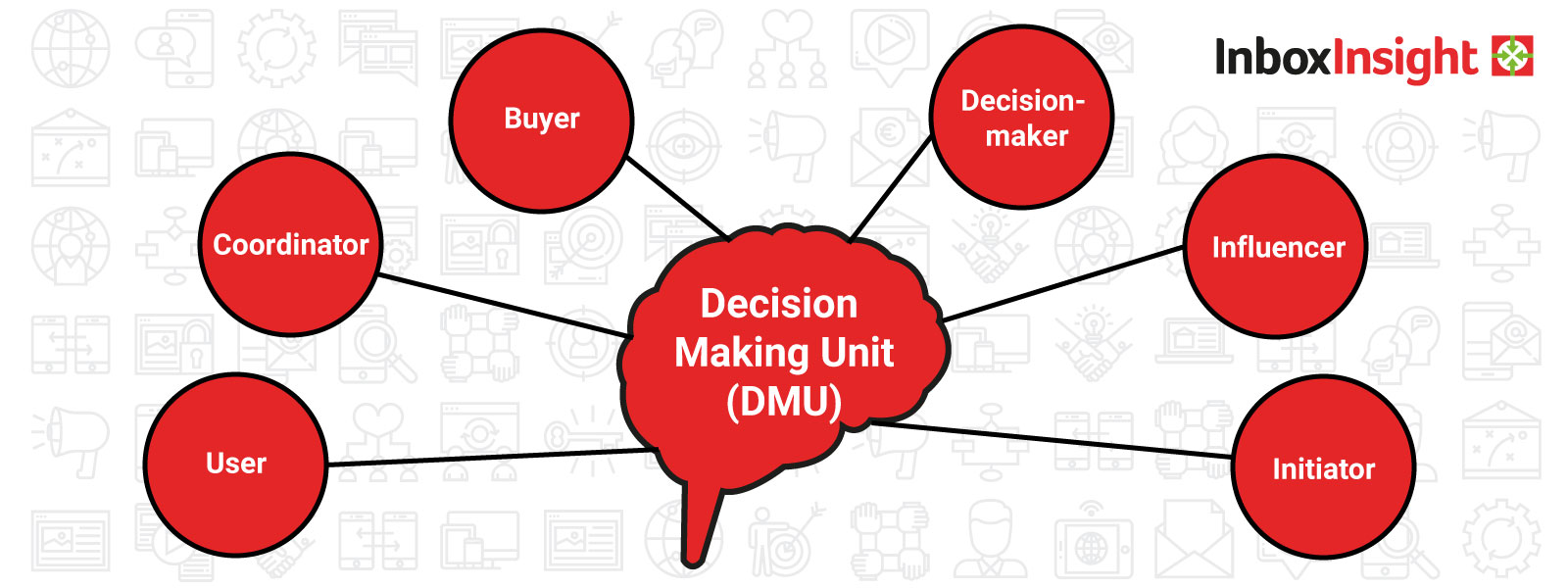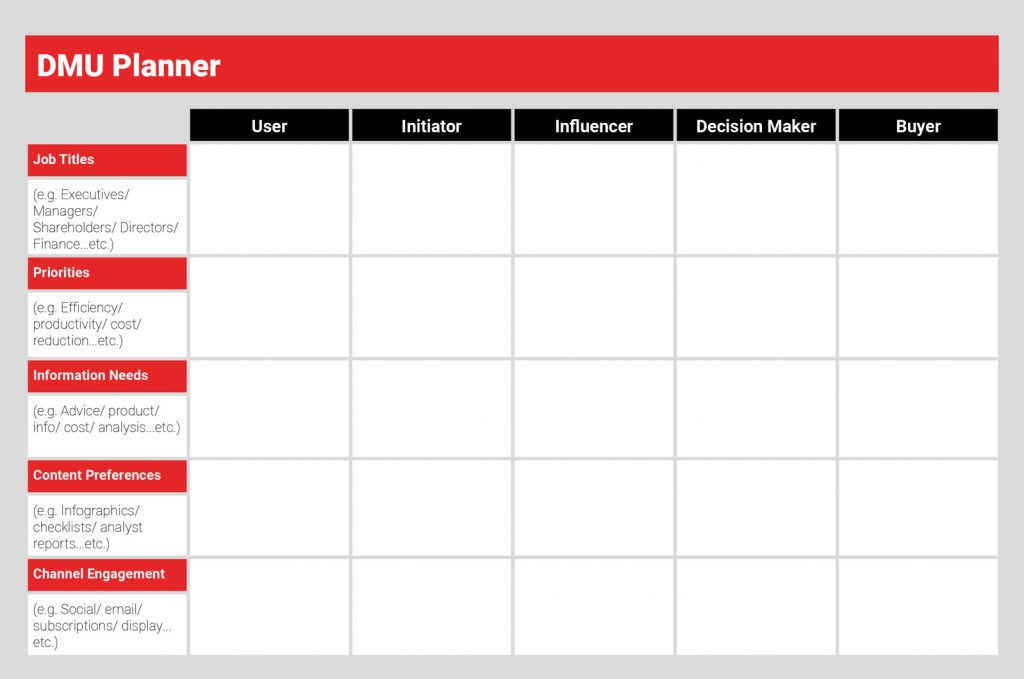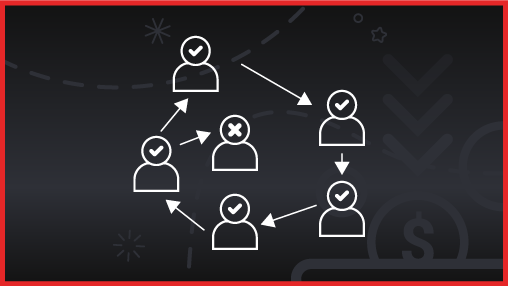Understanding the complexities of modern purchasing decisions is crucial for any successful marketing or sales strategy. The era of a single decision-maker dictating major business purchases is over. Today, we navigate a network of influencers, stakeholders, and decision-makers, each playing a vital role in the buying process. As we progress through 2024, staying informed on the latest B2B marketing developments is essential for effectively engaging these multifaceted Decision-Making Units (DMUs).
What is a Decision-Making Unit (DMU)?
A Decision-Making Unit is a group of individuals within an organization who work together to make a purchase decision. This is especially relevant in B2B transactions where buying decisions are complex and require the input of multiple stakeholders. Each member of the DMU has a unique role in the decision-making process, and their combined efforts ultimately determine the outcome of the purchasing decision.
Key characteristics of a DMU:
- Multiple stakeholders: DMUs typically comprise individuals from a diverse range of departments – including finance, operations, and management, among others
- Varied influence levels: Members possess different degrees of sway over the final decision, depending on their position and expertise
- Collective decision-making: The decision-making process is a collaborative effort, often demanding consensus or majority agreement
- Complex dynamics: The interaction within a DMU can be intricate due to the diverse priorities and goals of its members
The importance of the Decision-Making Unit in B2B
For vendors and sales professionals, understanding an organization’s DMU is essential for developing effective sales strategies. By tailoring communications to the specific concerns and interests of each DMU member, you can significantly increase the chances of a successful sale. This understanding also helps identify potential allies or opponents, enabling a more targeted approach.
Reading time: 9 minutes
The combined power of individual B2B decision makers
The B2B buying decision is made collectively. But to win over the majority of individual stakeholders that make up that buying collective, you’ve got to know what each member wants to hear, and when they want to hear it.
This statement brings forth two considerations:
- The individual needs of each stakeholder: 81% of B2B buyers now expect a personalized online buying experience
- The processes they go through when making a decision about you: 94% of B2B buyers research online at some point in the buying process
In order to address the above, it’s important to go back to marketing basics – the Decision Making Unit model (also known as a buying center). To aid in this, you can use a personal cheat sheet to create detailed buyer personas for each member of the DMU. This tool will help you understand their individual needs and decision-making processes better, allowing you to tailor your communications more effectively.
6 types of decision-makers

According to marketing professor and author David Kotler, there are 6 archetypes in the DMU:
- Initiator: The individual who initiates the need or identifies a problem that requires a solution
- Buyer: The person responsible for making the purchase, often handling financial aspects and negotiations
- Decision Maker: The individual with the authority to finalize the decision, giving the green light for the purchase
- Coordinator/Gatekeeper: This role involves managing information flow and controlling access to decision-makers, acting as a gatekeeper to the decision-making process
- Influencer: Those who can impact the decision-makers by providing insights, opinions, or recommendations
- User: The end-users or those who will directly interact with the product or service
Our recent research provides insights into the roles and influence of various DMU members:
- 48% of B2B decision-makers identified themselves as ultimate decision-makers, wielding significant influence in the purchasing process
- 22% of respondents classified themselves as influencers, playing a substantial role in shaping purchase decisions
- 75% of B2B decision-makers reported that they research and recommend solution providers, while another 75% evaluate technical requirements
These statistics highlight the diverse roles within the DMU and the importance of tailoring your approach to each stakeholder’s responsibilities and influence level.
Examples of a typical B2B DMU
| DMU member | Responsibilities | Influence | Example |
| Initiator | Identifies need for a new solution, starts conversation, conducts preliminary research | Sets direction for solutions, motivates DMU with urgency | Marketing manager identifies need for a new CRM, kickstarts the process, first contact for vendors, sets tone for essential features |
| Buyer | Holds budget, evaluates cost-effectiveness, negotiates terms | Direct impact on purchase decision, advocates for best value | Procurement officer negotiates with vendors based on requirements and budget, controls spending, affects selection through financial terms |
| Decision Maker | Approves or vetoes decisions, aligns purchase with company goals, considers long-term benefits and risks | Ultimate authority, strategic vision guides solution choice | CEO or department head evaluates CRM’s impact, makes final decision, strategic priorities drive choice |
| Coordinator | Organizes meetings, controls information flow, ensures procedures are followed | Facilitates or hinders information flow, affecting decision speed and effectiveness | Executive assistant manages schedules, sets up product demos, organizes follow-ups, controls information access |
| Influencer | Provides expert opinion, evaluates options, influences through reports or conversations | Shapes views with specialized knowledge, lends credibility to solutions | IT director assesses CRM compatibility, provides expert recommendations, influences DMU with technical expertise |
| User | Uses product daily, provides feedback on practicality and effectiveness | Direct stake in functionality, feedback can sway decision based on impact on efficiency and job satisfaction | Sales reps provide feedback on CRM needs, influence decision with their daily usage experience |
Each member plays a significant role in the B2B buying decision, regardless of seniority. This doesn’t necessarily mean you must create an individual content marketing strategy for each individual role, it does however show the importance of engaging more than one member.
ABM and DMU integration
As 88% of senior B2B marketers have noted improved conversion rates with ABM, it’s important to consider the connection between ABM and DMU. A common pitfall in adopting an ABM strategy is failing to account for all the members of the DMU in the B2B marketing segmentation strategy. With over 80% of businesses involving four or more people in the buying process, and 90% of business professionals acknowledging that at least one DMU member often tries to sway the decision in their favor, it’s clear that focusing solely on the main budget holder or C-suite executive is not enough.
For instance, have you ever seen a promising engagement with a prospect suddenly stall or not advance? This might be due to the influence of another DMU member. If your content doesn’t address the needs and priorities of all key stakeholders, your efforts might be undermined later on. However, by engaging all members of the DMU, your chances of success are considerably higher.
It’s time to recognize and leverage the influence of lower and mid-level stakeholders within your target account’s DMU. These individuals can be more accessible and can significantly influence the success of your campaign.
Understanding the modern DMU to improve your B2B targeting strategy
The DMU concept, first created by Webster and Wind in 1972, has evolved significantly. Here are several key changes affecting the Decision-Making Unit today:
- Millennials: 73% of 20-35 year olds are now involved in product or service purchase decisions at their companies. By 2025, 75% of the global workforce is predicted to be made up of millennials. This demographic, being digital natives, gravitates towards video and online content. Oh, and by the way – 75% of millennials find phone calls too time-consuming…
- Online buying: 61% of B2B buyers research products from their smartphones, with over half of all web traffic now existing on mobile phones. Meetings and phone calls with sales contacts now take place much later in the buying process. After completing their online research, buyers are choosing who they want to speak to. It’s an ‘invitation only’ sales shortlist. To make it onto the guest list, you must provide relevant information throughout the customer journey. Essentially, around 80% of all internet traffic is triggered by user intent; the need for information.
- Bigger DMUs: The DMU is growing – climbing from an average of 5.4 two years ago to 6.8 today. To reach this larger, more diverse group, marketing campaigns have to work harder than ever. This means creating more diverse audience personas and relevant content. One-size-fits-all is unlikely to succeed (Account-Based Marketing Research Report | Inbox Insight).
- Lengthier decision-making processes: Approximately 34% of companies have an average buying process that spans 3 to 6 months. This extended timeline highlights the critical need for sustained engagement with the DMU throughout the entire buying journey. Companies must recognize the importance of maintaining consistent and meaningful interactions to remain top-of-mind and effectively influence the decision-making process over these prolonged periods (B2B Tech Buyer Behavior | Inbox Insight).
- Digital resources: A significant portion of B2B buyers prefer using various online resources when researching business challenges. 60% of these buyers use software comparison websites to inform their decisions, while, 46% now rely on generative AI tools for conducting their research (B2B Tech Buyer Behavior | Inbox Insight).
How can I map the DMU to better plan my demand generation campaigns?
We’ve created the following template to assist with your digital campaign planning. Through mapping each member of your target audience’s DMU, you can begin building a better B2B content strategy that delivers the right content to the right person in the right way. For instance, understanding the preferences and decision-making behaviors of your DMU allows you to design the best demand generation campaigns, ensuring each stakeholder is engaged effectively. Additionally, once you’ve captured leads, it’s crucial to follow up strategically to maintain engagement. For tips on how to do this effectively, check out our guide on how to follow up with whitepaper leads.

What other factors shape the mindset of modern B2B Decision Makers?
The traditional notion of a B2B DMU stakeholder as a rational, calm and calculated buyer immune to emotion is shifting, especially when you consider the impact the talent shortage, social media and a growing millennial workforce have on the importance of cultivating employee wellbeing and company culture. Millennials are replacing retiring baby boomers, bringing different aspirations, beliefs and values to the workplace. 94% of business professionals believe company culture is important to an organization’s success.
In a digital age where we’re encouraged to think and feel, in equal measures, can we afford to neglect the emotional side of a B2B buyer? In fact, in a major study partnered with Google it was revealed on average, B2B customers are significantly more emotionally connected to their vendors and service providers than consumers and are 50% more likely to buy a product or service when they see personal value (Google, CEB Marketing, Motista).
What’s more, further CEB research suggests the phycological impact of living in an abundance of choice and information is taking its toll, leaving many buyers deeply uncertain, stressed and overwhelmed (Harvard Business Review).
With this in mind, here are 10 questions to help tap into the psyche of your B2B buyers:
- Who are they trying to impress? (Other members in the DMU, peers, family…etc.)
- What struggles are they going through? (Professional/personal…etc.)
- How can your content make their jobs easier? (Gain back time, increase productivity…etc.)
- What trends or topics do they follow? (Intent data, subsciptions…etc)
- What content are they likely to share in their LinkedIn feed? (Curated content, their own thought leadership, news alerts…etc)
- What knowledge will make them look good in front of peers and other stakeholders? (Thought leadership, strategic input, trend forecasting…etc.)
- Who do they trust? (Thought leaders, peer groups…etc.)
- Who do they aspire to become? (CEO, Director, Thought Leader…etc)
- Which Tone of Voice (ToV) resonates best? (Specialist terminology vs accessible language, warm vs authoritative tone…etc)
- How can you simplify their decision making process? (Prescriptive approach, nurture process…etc.)
The bottom line
The more you uncover what makes your target audience tick, the more accurately you can plan your communications to deliver the best content experiences that result in a purchase. This includes factoring in all the key stakeholders, after all, many individuals lead to one powerful and coercive buying collective.
Discover how our B2B demand generation services can help you effectively engage every member of the DMU with targeted, personalized content that drives successful outcomes. Get in touch with us today.






